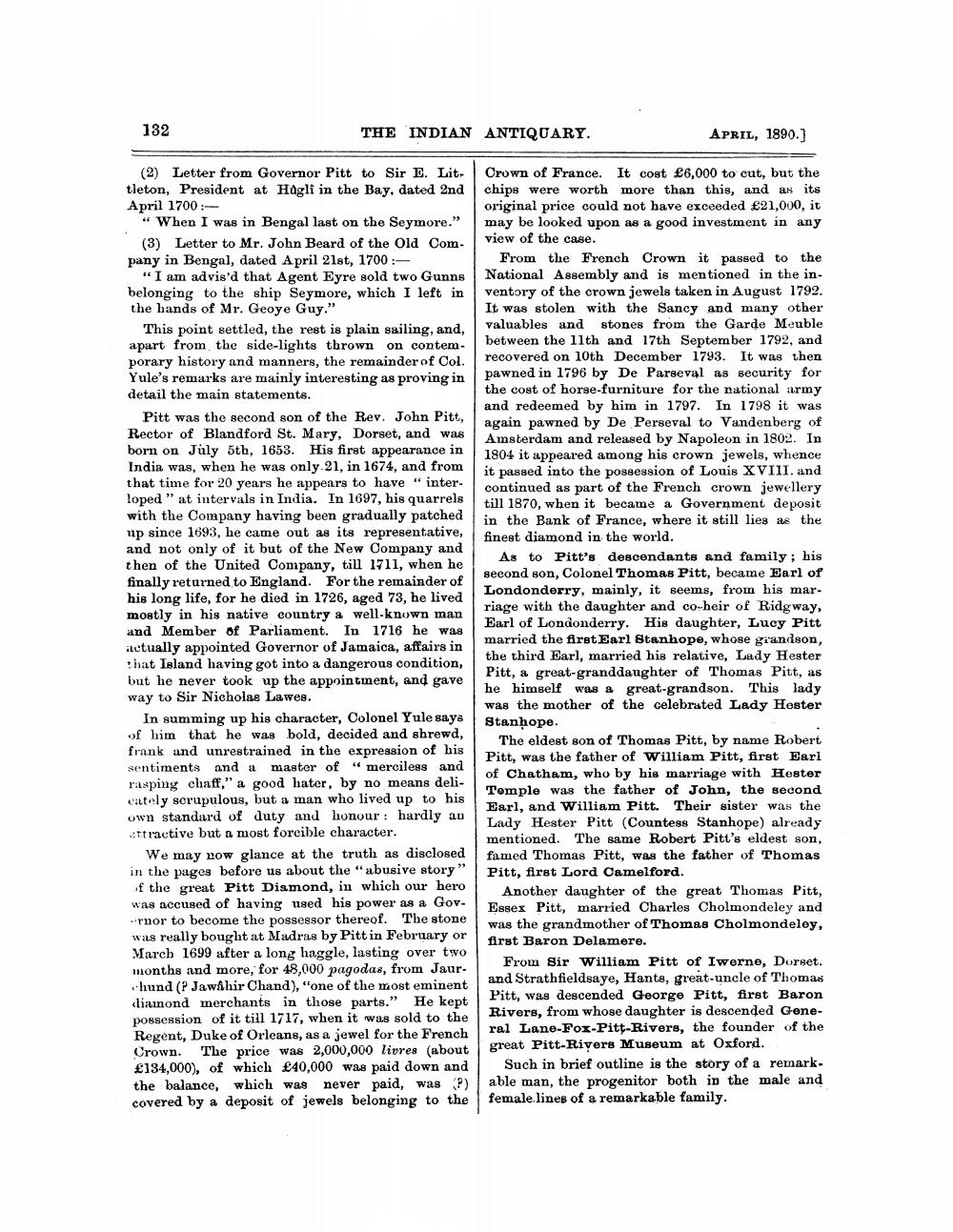________________
132
THE INDIAN ANTIQUARY.
APRIL, 1890.]
(2) Letter from Governor Pitt to Sir E. Lit tleton, President at Hägli in the Bay, dated 2nd April 1700:
“When I was in Bengal last on the Seymore."
(3) Letter to Mr. John Beard of the Old Com. pany in Bengal, dated April 21st, 1700:
"I am advis'd that Agent Eyre sold two Gunns belonging to the ship Seymore, which I left in the hands of Mr. Geoye Guy."
This point settled, the rest is plain sailing, and, apart from the side-lights thrown on contemporary history and manners, the remainder of Col. Yule's remarks are mainly interesting as proving in detail the main statements.
Pitt was the second son of the Rev. John Pitt, Rector of Blandford St. Mary, Dorset, and was born on July 5th, 1653. His first appearance in India was, when he was only 21, in 1674, and from that time for 20 years he appears to have " interloped" at intervals in India. In 1697, his quarrels with the Company having been gradually patched np since 1693, he came out as its representative, and not only of it but of the New Company and then of the United Company, till 1711, when he finally returned to England. For the remainder of his long life, for he died in 1726, aged 73, he lived mostly in his native country a well-known man and Member of Parliament. In 1716 he was itctually appointed Governor of Jamaica, affairs in that Island having got into a dangerous condition, but he never took up the appointment, and gave way to Sir Nicholas Lawes.
In summing up his character, Colonel Yule says of him that he was bold, decided and shrewd, frank and unrestrained in the expression of his sentiments and a master of " merciless and rasping chaff," a good hater, by no means delicately scrupulous, but a man who lived up to his own standard of duty and honour: hardly au attractive but a most forcible character.
We may now glance at the truth as disclosed in the pages before us about the "abusive story” of the great Pitt Diamond, in which our hero was accused of having used his power as a Gov.
mnor to become the possessor thereof. The stone was really bought at Madras by Pitt in February or March 1699 after a long haggle, lasting over two months and more, for 48,000 pagodas, from Jaur.
hund (P Jawahir Chand), "one of the most eminent diamond merchants in those parts." He kept possession of it till 1717, when it was sold to the Regent, Duke of Orleans, as a jewel for the French Crown. The price was 2,000,000 livres (about £134,000), of which £40,000 was paid down and the balance, which was never paid, was covered by a deposit of jewels belonging to the
Crown of France. It cost £6,000 to cut, but the chips were worth more than this, and as its original price could not have exceeded £21,000, it may be looked upon as a good investment in any view of the case.
From the French Crown it passed to the National Assembly and is mentioned in the inventory of the crown jewels taken in August 1792. It was stolen with the Sancy and many other valuables and stones from the Garde Meuble between the 11th and 17th September 1792, and recovered on 10th December 1793. It was then pawned in 1796 by De Parseval as security for the cost of horse-furniture for the national army and redeemed by him in 1797. In 1798 it was again pawned by De Perseval to Vandenberg of Amsterdam and released by Napoleon in 1802. In 1804 it appeared among his crown jewels, whence it passed into the possession of Louis XVIII. and continued as part of the French crown jewellery till 1870, when it became a Government deposit in the Bank of France, where it still lies as the finest diamond in the world.
As to Pitt's descendants and family; his second son, Colonel Thomas Pitt, became Earl of Londonderry, mainly, it seems, from his marriage with the daughter and co-heir of Ridgway, Earl of Londonderry. His daughter, Lucy Pitt married the first Earl Stanhope, whose grandson, the third Earl, married his relative, Lady Hester Pitt, a great-granddaughter of Thomas Pitt, as he himself was a great-grandson. This lady was the mother of the celebrated Lady Hester Stanhope.
The eldest son of Thomas Pitt, by name Robert Pitt, was the father of William Pitt, first Earl of Chatham, who by his marriage with Hester Temple was the father of John, the second Earl, and William Pitt. Their sister was the Lady Hester Pitt (Countess Stanhope) already mentioned. The same Robert Pitt's eldest son, famed Thomas Pitt, was the father of Thomas Pitt, first Lord Camelford.
Another daughter of the great Thomas Pitt, Essex Pitt, married Charles Cholmondeley and was the grandmother of Thomas Cholmondeloy, first Baron Delamere.
From Sir William Pitt of Iwerne, Dorset. and Strathfieldsaye, Hants, great-uncle of Thomas Pitt, was descended George Pitt, first Baron Rivers, from whose daughter is descended Goneral Lane-Fox-Pitt-Rivers, the founder of the great Pitt-Rivers Museum at Oxford.
Such in brief outline is the story of a remarkable man, the progenitor both in the male and female lines of a remarkable family.




